NISSAN QASHQAI 2016 Owner´s Manual
Manufacturer: NISSAN, Model Year: 2016, Model line: QASHQAI, Model: NISSAN QASHQAI 2016Pages: 338, PDF Size: 4.87 MB
Page 301 of 338
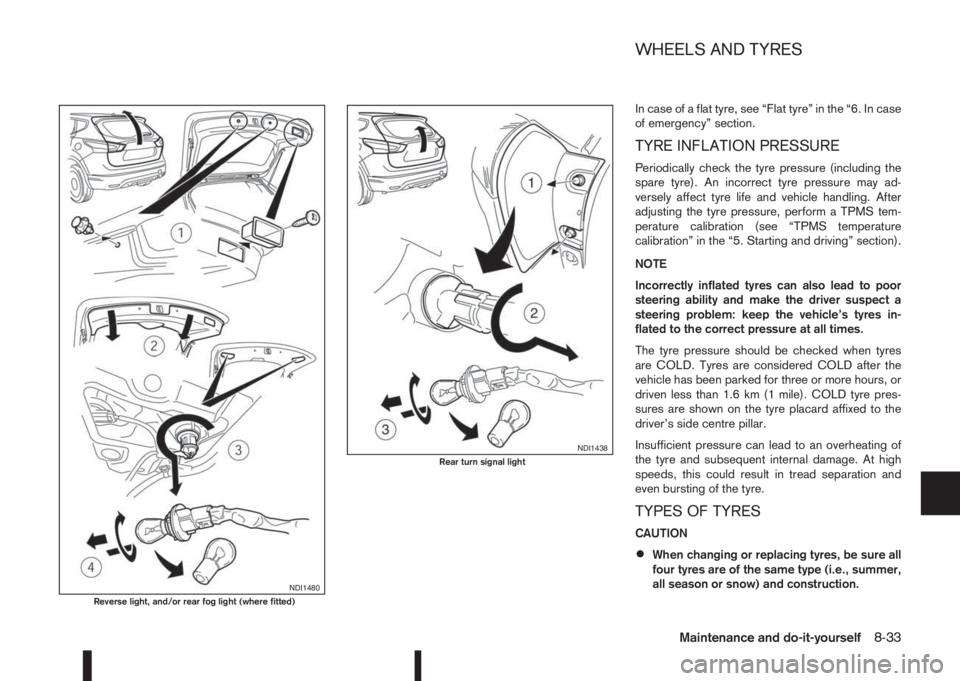
In case of a flat tyre, see “Flat tyre” in the “6. In case
of emergency” section.
TYRE INFLATION PRESSURE
Periodically check the tyre pressure (including the
spare tyre). An incorrect tyre pressure may ad-
versely affect tyre life and vehicle handling. After
adjusting the tyre pressure, perform a TPMS tem-
perature calibration (see “TPMS temperature
calibration” in the “5. Starting and driving” section).
NOTE
Incorrectly inflated tyres can also lead to poor
steering ability and make the driver suspect a
steering problem: keep the vehicle’s tyres in-
flated to the correct pressure at all times.
The tyre pressure should be checked when tyres
are COLD. Tyres are considered COLD after the
vehicle has been parked for three or more hours, or
driven less than 1.6 km (1 mile). COLD tyre pres-
sures are shown on the tyre placard affixed to the
driver’s side centre pillar.
Insufficient pressure can lead to an overheating of
the tyre and subsequent internal damage. At high
speeds, this could result in tread separation and
even bursting of the tyre.
TYPES OF TYRES
CAUTION
•When changing or replacing tyres, be sure all
four tyres are of the same type (i.e., summer,
all season or snow) and construction.
NDI1480Reverse light, and/or rear fog light (where fitted)
NDI1438Rear turn signal light
WHEELS AND TYRES
Maintenance and do-it-yourself8-33
Page 302 of 338
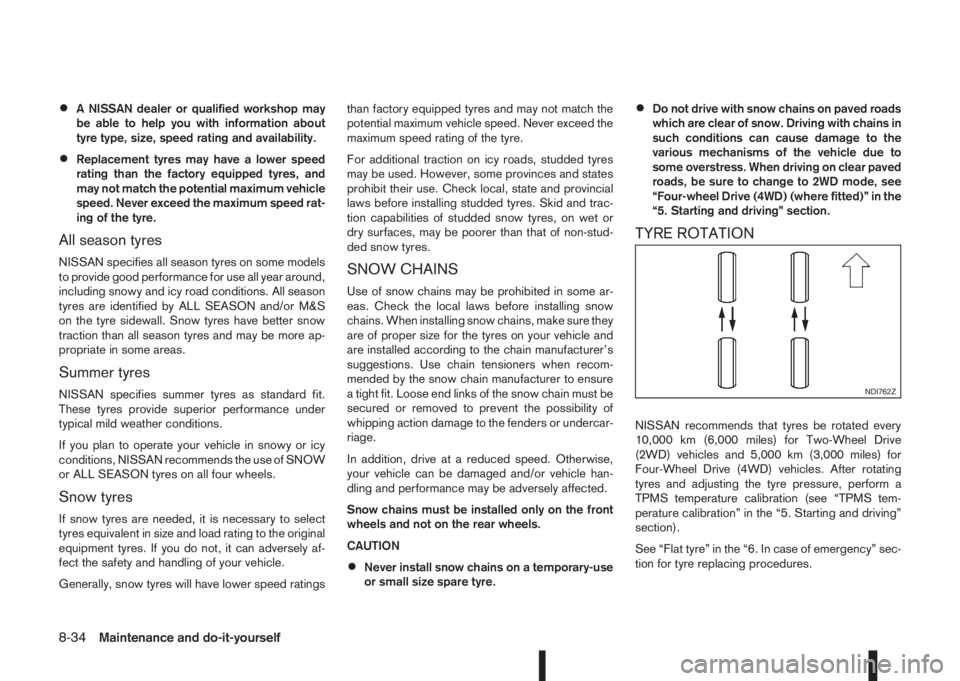
•A NISSAN dealer or qualified workshop may
be able to help you with information about
tyre type, size, speed rating and availability.
•Replacement tyres may have a lower speed
rating than the factory equipped tyres, and
may not match the potential maximum vehicle
speed. Never exceed the maximum speed rat-
ing of the tyre.
All season tyres
NISSAN specifies all season tyres on some models
to provide good performance for use all year around,
including snowy and icy road conditions. All season
tyres are identified by ALL SEASON and/or M&S
on the tyre sidewall. Snow tyres have better snow
traction than all season tyres and may be more ap-
propriate in some areas.
Summer tyres
NISSAN specifies summer tyres as standard fit.
These tyres provide superior performance under
typical mild weather conditions.
If you plan to operate your vehicle in snowy or icy
conditions, NISSAN recommends the use of SNOW
or ALL SEASON tyres on all four wheels.
Snow tyres
If snow tyres are needed, it is necessary to select
tyres equivalent in size and load rating to the original
equipment tyres. If you do not, it can adversely af-
fect the safety and handling of your vehicle.
Generally, snow tyres will have lower speed ratingsthan factory equipped tyres and may not match the
potential maximum vehicle speed. Never exceed the
maximum speed rating of the tyre.
For additional traction on icy roads, studded tyres
may be used. However, some provinces and states
prohibit their use. Check local, state and provincial
laws before installing studded tyres. Skid and trac-
tion capabilities of studded snow tyres, on wet or
dry surfaces, may be poorer than that of non-stud-
ded snow tyres.
SNOW CHAINS
Use of snow chains may be prohibited in some ar-
eas. Check the local laws before installing snow
chains. When installing snow chains, make sure they
are of proper size for the tyres on your vehicle and
are installed according to the chain manufacturer’s
suggestions. Use chain tensioners when recom-
mended by the snow chain manufacturer to ensure
a tight fit. Loose end links of the snow chain must be
secured or removed to prevent the possibility of
whipping action damage to the fenders or undercar-
riage.
In addition, drive at a reduced speed. Otherwise,
your vehicle can be damaged and/or vehicle han-
dling and performance may be adversely affected.
Snow chains must be installed only on the front
wheels and not on the rear wheels.
CAUTION
•Never install snow chains on a temporary-use
or small size spare tyre.
•Do not drive with snow chains on paved roads
which are clear of snow. Driving with chains in
such conditions can cause damage to the
various mechanisms of the vehicle due to
some overstress. When driving on clear paved
roads, be sure to change to 2WD mode, see
“Four-wheel Drive (4WD) (where fitted)” in the
“5. Starting and driving” section.
TYRE ROTATION
NISSAN recommends that tyres be rotated every
10,000 km (6,000 miles) for Two-Wheel Drive
(2WD) vehicles and 5,000 km (3,000 miles) for
Four-Wheel Drive (4WD) vehicles. After rotating
tyres and adjusting the tyre pressure, perform a
TPMS temperature calibration (see “TPMS tem-
perature calibration” in the “5. Starting and driving”
section).
See “Flat tyre” in the “6. In case of emergency” sec-
tion for tyre replacing procedures.
NDI762Z
8-34Maintenance and do-it-yourself
Page 303 of 338
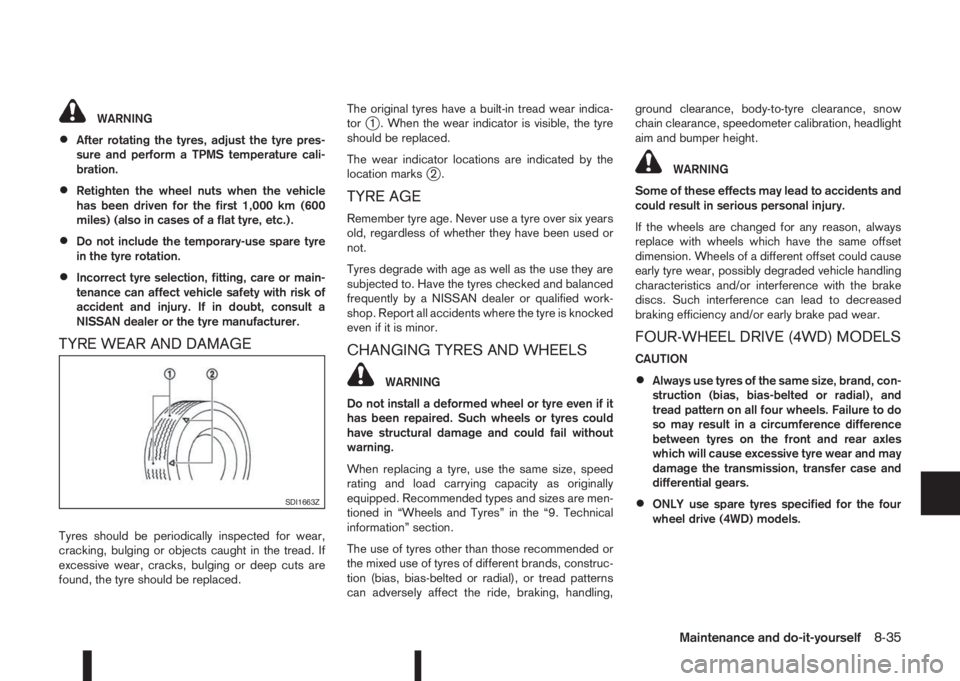
WARNING
•After rotating the tyres, adjust the tyre pres-
sure and perform a TPMS temperature cali-
bration.
•Retighten the wheel nuts when the vehicle
has been driven for the first 1,000 km (600
miles) (also in cases of a flat tyre, etc.).
•Do not include the temporary-use spare tyre
in the tyre rotation.
•Incorrect tyre selection, fitting, care or main-
tenance can affect vehicle safety with risk of
accident and injury. If in doubt, consult a
NISSAN dealer or the tyre manufacturer.
TYRE WEAR AND DAMAGE
Tyres should be periodically inspected for wear,
cracking, bulging or objects caught in the tread. If
excessive wear, cracks, bulging or deep cuts are
found, the tyre should be replaced.The original tyres have a built-in tread wear indica-
tor
j1 . When the wear indicator is visible, the tyre
should be replaced.
The wear indicator locations are indicated by the
location marks
j2.
TYRE AGE
Remember tyre age. Never use a tyre over six years
old, regardless of whether they have been used or
not.
Tyres degrade with age as well as the use they are
subjected to. Have the tyres checked and balanced
frequently by a NISSAN dealer or qualified work-
shop. Report all accidents where the tyre is knocked
even if it is minor.
CHANGING TYRES AND WHEELS
WARNING
Do not install a deformed wheel or tyre even if it
has been repaired. Such wheels or tyres could
have structural damage and could fail without
warning.
When replacing a tyre, use the same size, speed
rating and load carrying capacity as originally
equipped. Recommended types and sizes are men-
tioned in “Wheels and Tyres” in the “9. Technical
information” section.
The use of tyres other than those recommended or
the mixed use of tyres of different brands, construc-
tion (bias, bias-belted or radial), or tread patterns
can adversely affect the ride, braking, handling,ground clearance, body-to-tyre clearance, snow
chain clearance, speedometer calibration, headlight
aim and bumper height.
WARNING
Some of these effects may lead to accidents and
could result in serious personal injury.
If the wheels are changed for any reason, always
replace with wheels which have the same offset
dimension. Wheels of a different offset could cause
early tyre wear, possibly degraded vehicle handling
characteristics and/or interference with the brake
discs. Such interference can lead to decreased
braking efficiency and/or early brake pad wear.
FOUR-WHEEL DRIVE (4WD) MODELS
CAUTION
•Always use tyres of the same size, brand, con-
struction (bias, bias-belted or radial), and
tread pattern on all four wheels. Failure to do
so may result in a circumference difference
between tyres on the front and rear axles
which will cause excessive tyre wear and may
damage the transmission, transfer case and
differential gears.
•ONLY use spare tyres specified for the four
wheel drive (4WD) models.SDI1663Z
Maintenance and do-it-yourself8-35
Page 304 of 338
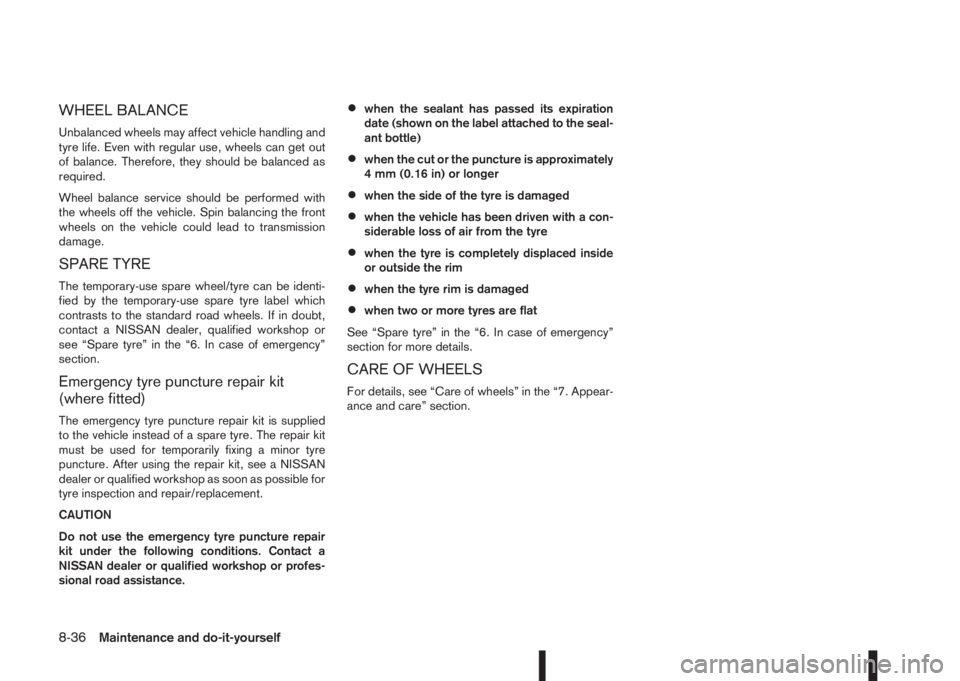
WHEEL BALANCE
Unbalanced wheels may affect vehicle handling and
tyre life. Even with regular use, wheels can get out
of balance. Therefore, they should be balanced as
required.
Wheel balance service should be performed with
the wheels off the vehicle. Spin balancing the front
wheels on the vehicle could lead to transmission
damage.
SPARE TYRE
The temporary-use spare wheel/tyre can be identi-
fied by the temporary-use spare tyre label which
contrasts to the standard road wheels. If in doubt,
contact a NISSAN dealer, qualified workshop or
see “Spare tyre” in the “6. In case of emergency”
section.
Emergency tyre puncture repair kit
(where fitted)
The emergency tyre puncture repair kit is supplied
to the vehicle instead of a spare tyre. The repair kit
must be used for temporarily fixing a minor tyre
puncture. After using the repair kit, see a NISSAN
dealer or qualified workshop as soon as possible for
tyre inspection and repair/replacement.
CAUTION
Do not use the emergency tyre puncture repair
kit under the following conditions. Contact a
NISSAN dealer or qualified workshop or profes-
sional road assistance.
•when the sealant has passed its expiration
date (shown on the label attached to the seal-
ant bottle)
•when the cut or the puncture is approximately
4 mm (0.16 in) or longer
•when the side of the tyre is damaged
•when the vehicle has been driven with a con-
siderable loss of air from the tyre
•when the tyre is completely displaced inside
or outside the rim
•when the tyre rim is damaged
•when two or more tyres are flat
See “Spare tyre” in the “6. In case of emergency”
section for more details.
CARE OF WHEELS
For details, see “Care of wheels” in the “7. Appear-
ance and care” section.
8-36Maintenance and do-it-yourself
Page 305 of 338
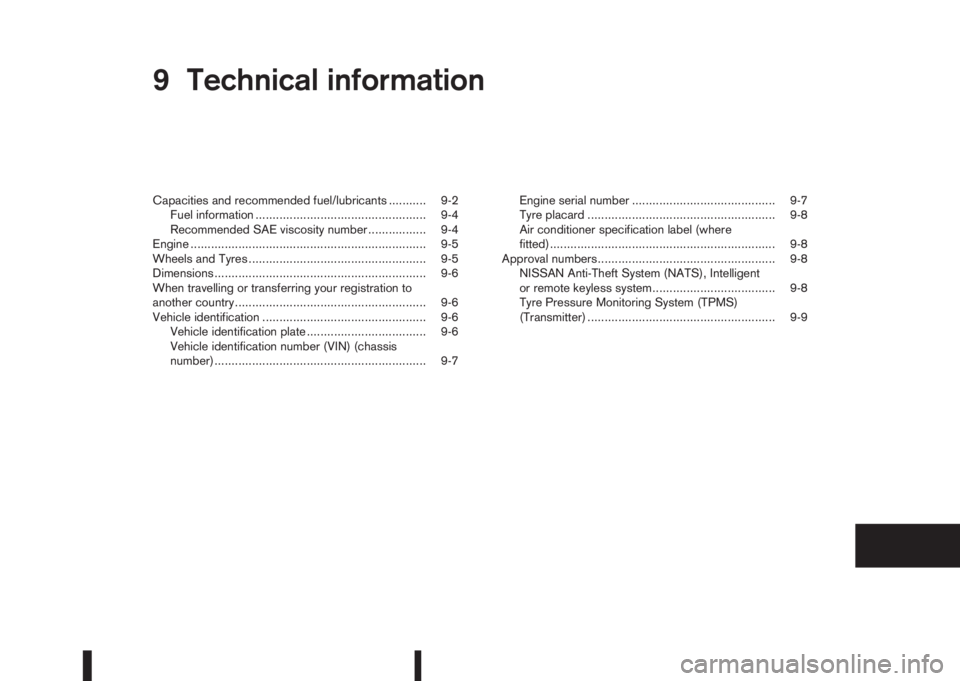
9Technical informationTechnical information
Capacities and recommended fuel/lubricants ........... 9-2
Fuel information .................................................. 9-4
Recommended SAE viscosity number ................. 9-4
Engine ..................................................................... 9-5
Wheels and Tyres .................................................... 9-5
Dimensions .............................................................. 9-6
When travelling or transferring your registration to
another country........................................................ 9-6
Vehicle identification ................................................ 9-6
Vehicle identification plate ................................... 9-6
Vehicle identification number (VIN) (chassis
number).............................................................. 9-7Engine serial number .......................................... 9-7
Tyre placard ....................................................... 9-8
Air conditioner specification label (where
fitted).................................................................. 9-8
Approval numbers.................................................... 9-8
NISSAN Anti-Theft System (NATS), Intelligent
or remote keyless system.................................... 9-8
Tyre Pressure Monitoring System (TPMS)
(Transmitter) ....................................................... 9-9
Page 306 of 338
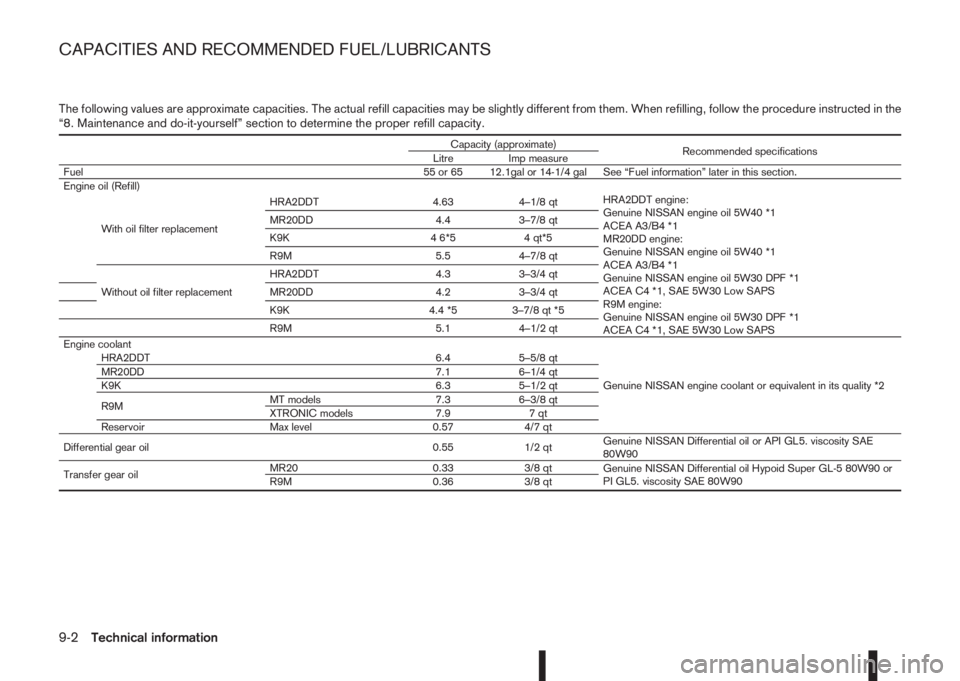
The following values are approximate capacities. The actual refill capacities may be slightly different from them. When refilling, follow the procedure instructed in the
“8. Maintenance and do-it-yourself” section to determine the proper refill capacity.
Capacity (approximate)
Recommended specifications
Litre Imp measure
Fuel 55 or 65 12.1gal or 14-1/4 gal See “Fuel information” later in this section
.Engine oil (Refill)
With oil filter replacementHRA2DDT 4.63 4–1/8 qtHRA2DDT engine:
Genuine NISSAN engine oil 5W40 *1
ACEA A3/B4 *1
MR20DD engine:
Genuine NISSAN engine oil 5W40 *1
ACEA A3/B4 *1
Genuine NISSAN engine oil 5W30 DPF *1
ACEA C4 *1, SAE 5W30 Low SAPS
R9M engine:
Genuine NISSAN engine oil 5W30 DPF *1
ACEA C4 *1, SAE 5W30 Low SAPS MR20DD 4.4 3–7/8 qt
K9K 4 6*5 4 qt*5
R9M 5.5 4–7/8 qt
Without oil filter replacementHRA2DDT 4.3 3–3/4 qt
MR20DD 4.2 3–3/4 qt
K9K 4.4 *5 3–7/8 qt *5
R9M 5.1 4–1/2 qt
Engine coolant
Genuine NISSAN engine coolant or equivalent in its quality *2 HRA2DDT 6.4 5–5/8 qt
MR20DD 7.1 6–1/4 qt
K9K 6.3 5–1/2 qt
R9MMT models 7.3 6–3/8 qt
XTRONIC models 7.9 7 qt
Reservoir Max level 0.57 4/7 qt
Differential gear oil 0.55 1/2 qtGenuine NISSAN Differential oil or API GL5. viscosity SAE
80W90
Transfer gear oilMR20 0.33 3/8 qt
Genuine NISSAN Differential oil Hypoid Super GL-5 80W90 or
PI GL5. viscosity SAE 80W90
R9M 0.36 3/8 qt
CAPACITIES AND RECOMMENDED FUEL/LUBRICANTS
9-2Technical information
Page 307 of 338
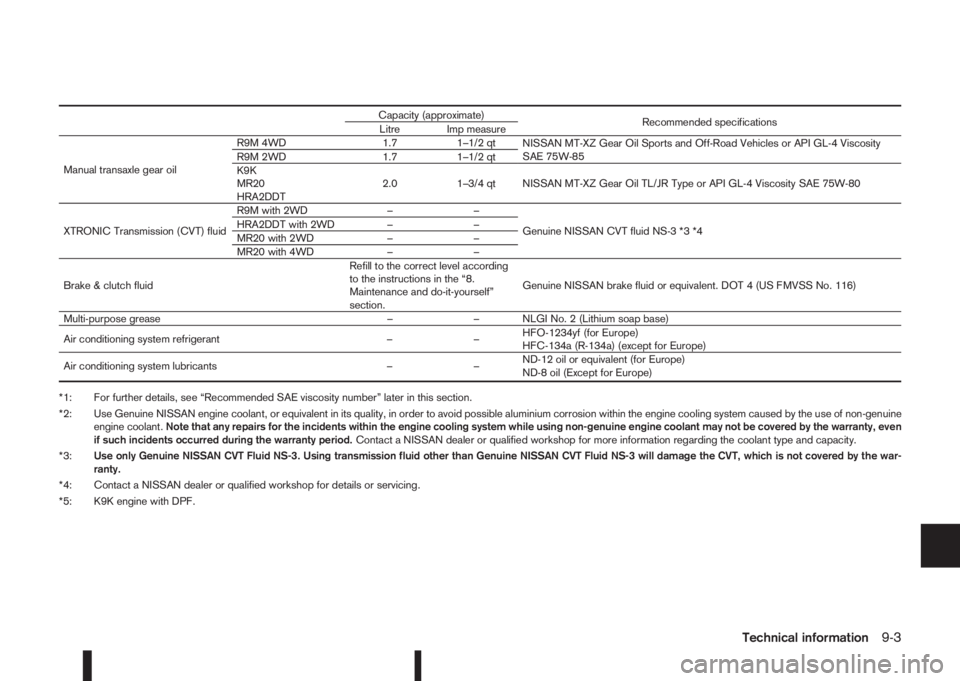
Capacity (approximate)
Recommended specifications
Litre Imp measure
Manual transaxle gear oilR9M 4WD 1.7 1–1/2 qt
NISSAN MT-XZ Gear Oil Sports and Off-Road Vehicles or API GL-4 Viscosity
SAE 75W-85
R9M 2WD 1.7 1–1/2 qt
K9K
MR20
HRA2DDT2.0 1–3/4 qt NISSAN MT-XZ Gear Oil TL/JR Type or API GL-4 Viscosity SAE 75W-80
XTRONIC Transmission (CVT) fluidR9M with 2WD – –
Genuine NISSAN CVT fluid NS-3 *3 *4 HRA2DDT with 2WD – –
MR20 with 2WD – –
MR20 with 4WD – –
Brake & clutch fluidRefill to the correct level according
to the instructions in the “8.
Maintenance and do-it-yourself”
section.Genuine NISSAN brake fluid or equivalent. DOT 4 (US FMVSS No. 116)
Multi-purpose grease – – NLGI No. 2 (Lithium soap base)
Air conditioning system refrigerant – –HFO-1234yf (for Europe)
HFC-134a (R-134a) (except for Europe)
Air conditioning system lubricants – –ND-12 oil or equivalent (for Europe)
ND-8 oil (Except for Europe)
*1: For further details, see “Recommended SAE viscosity number” later in this section.
*2: Use Genuine NISSAN engine coolant, or equivalent in its quality, in order to avoid possible aluminium corrosion within the engine cooling system caused by the use of non-genuine
engine coolant.Note that any repairs for the incidents within the engine cooling system while using non-genuine engine coolant may not be covered by the warranty, even
if such incidents occurred during the warranty period.Contact a NISSAN dealer or qualified workshop for more information regarding the coolant type and capacity.
*3:Use only Genuine NISSAN CVT Fluid NS-3. Using transmission fluid other than Genuine NISSAN CVT Fluid NS-3 will damage the CVT, which is not covered by the war-
ranty.
*4: Contact a NISSAN dealer or qualified workshop for details or servicing.
*5: K9K engine with DPF.
Technical information9-3
Page 308 of 338
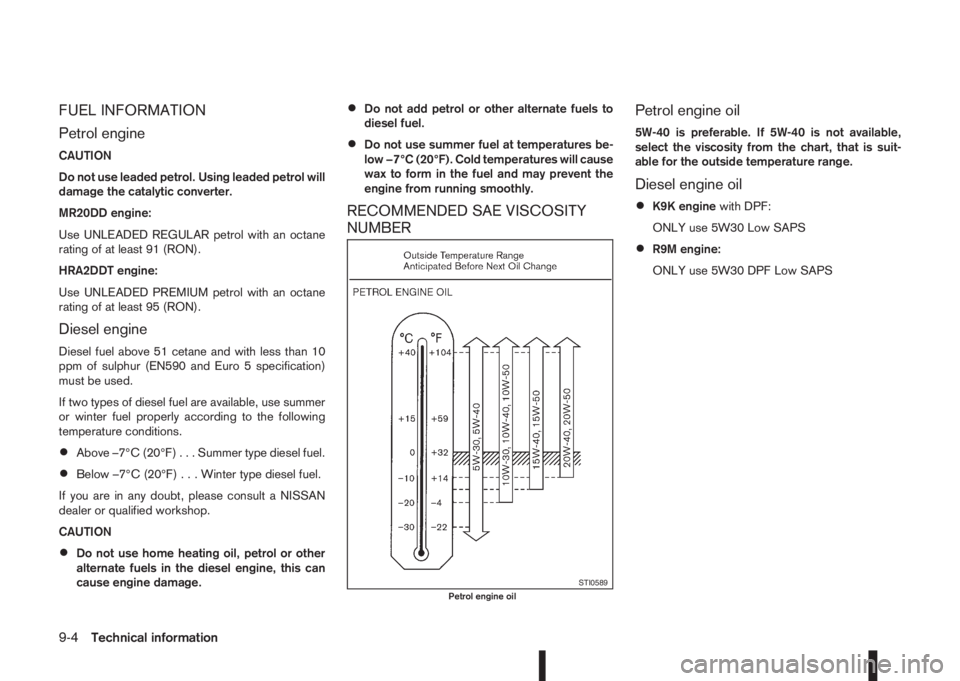
FUEL INFORMATION
Petrol engine
CAUTION
Do not use leaded petrol. Using leaded petrol will
damage the catalytic converter.
MR20DD engine:
Use UNLEADED REGULAR petrol with an octane
rating of at least 91 (RON).
HRA2DDT engine:
Use UNLEADED PREMIUM petrol with an octane
rating of at least 95 (RON).
Diesel engine
Diesel fuel above 51 cetane and with less than 10
ppm of sulphur (EN590 and Euro 5 specification)
must be used.
If two types of diesel fuel are available, use summer
or winter fuel properly according to the following
temperature conditions.
•Above –7°C (20°F)...Summer type diesel fuel.
•Below–7°C(20°F)...Wintertypedieselfuel.
If you are in any doubt, please consult a NISSAN
dealer or qualified workshop.
CAUTION
•Do not use home heating oil, petrol or other
alternate fuels in the diesel engine, this can
cause engine damage.
•Do not add petrol or other alternate fuels to
diesel fuel.
•Do not use summer fuel at temperatures be-
low −7°C (20°F). Cold temperatures will cause
wax to form in the fuel and may prevent the
engine from running smoothly.
RECOMMENDED SAE VISCOSITY
NUMBERPetrol engine oil
5W-40 is preferable. If 5W-40 is not available,
select the viscosity from the chart, that is suit-
able for the outside temperature range.
Diesel engine oil
•K9K enginewith DPF:
ONLY use 5W30 Low SAPS
•R9M engine:
ONLY use 5W30 DPF Low SAPS
STI0589Petrol engine oil
9-4Technical information
Page 309 of 338
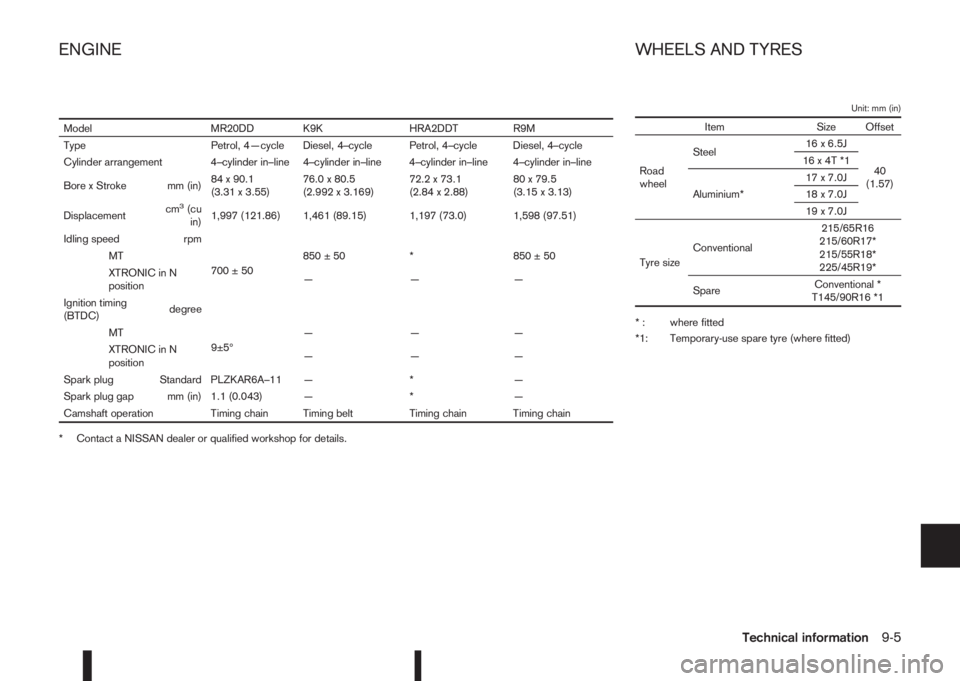
Unit: mm (in)
Item Size Offset
Road
wheelSteel16 x 6.5J
40
(1.57) 16x4T*1
Aluminium*17 x 7.0J
18 x 7.0J
19 x 7.0J
Tyre sizeConventional215/65R16
215/60R17*
215/55R18*
225/45R19*
SpareConventional *
T145/90R16 *1
* : where fitted
*1: Temporary-use spare tyre (where fitted)Model MR20DD K9K HRA2DDT R9M
Type Petrol, 4—cycle Diesel, 4–cycle Petrol, 4–cycle Diesel, 4–cycle
Cylinder arrangement 4–cylinder in–line 4–cylinder in–line 4–cylinder in–line 4–cylinder in–line
Bore x Stroke mm (in)84 x 90.1
(3.31 x 3.55)76.0 x 80.5
(2.992 x 3.169)72.2 x 73.1
(2.84 x 2.88)80 x 79.5
(3.15 x 3.13)
Displacementcm
3(cu
in)1,997 (121.86) 1,461 (89.15) 1,197 (73.0) 1,598 (97.51)
Idling speed rpm
MT
700 ± 50850±50 * 850±50
XTRONIC in N
position———
Ignition timing
(BTDC)degree
MT
9±5°———
XTRONIC in N
position———
Spark plug Standard PLZKAR6A–11 — * —
Spark plug gap mm (in) 1.1 (0.043) — * —
Camshaft operation Timing chain Timing belt Timing chain Timing chain
* Contact a NISSAN dealer or qualified workshop for details.
ENGINE WHEELS AND TYRES
Technical information9-5
Page 310 of 338
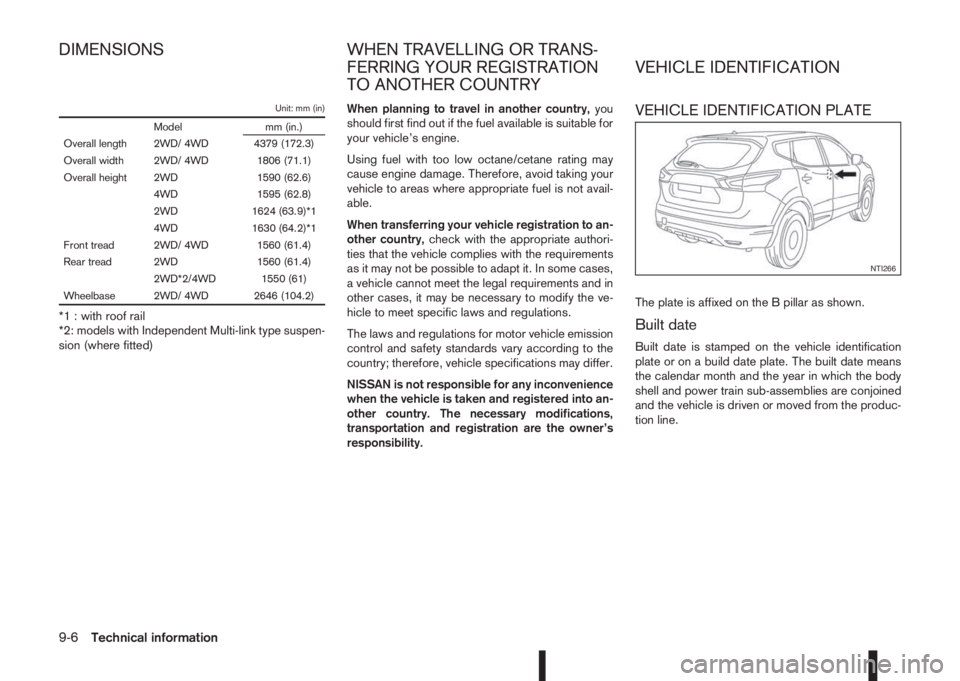
Unit: mm (in)
Model mm (in.)
Overall length 2WD/ 4WD 4379 (172.3)
Overall width 2WD/ 4WD 1806 (71.1)
Overall height 2WD 1590 (62.6)
4WD 1595 (62.8)
2WD 1624 (63.9)*1
4WD 1630 (64.2)*1
Front tread 2WD/ 4WD 1560 (61.4)
Rear tread 2WD 1560 (61.4)
2WD*2/4WD 1550 (61)
Wheelbase 2WD/ 4WD 2646 (104.2)
*1 : with roof rail
*2: models with Independent Multi-link type suspen-
sion (where fitted)When planning to travel in another country,you
should first find out if the fuel available is suitable for
your vehicle’s engine.
Using fuel with too low octane/cetane rating may
cause engine damage. Therefore, avoid taking your
vehicle to areas where appropriate fuel is not avail-
able.
When transferring your vehicle registration to an-
other country,check with the appropriate authori-
ties that the vehicle complies with the requirements
as it may not be possible to adapt it. In some cases,
a vehicle cannot meet the legal requirements and in
other cases, it may be necessary to modify the ve-
hicle to meet specific laws and regulations.
The laws and regulations for motor vehicle emission
control and safety standards vary according to the
country; therefore, vehicle specifications may differ.
NISSAN is not responsible for any inconvenience
when the vehicle is taken and registered into an-
other country. The necessary modifications,
transportation and registration are the owner’s
responsibility.
VEHICLE IDENTIFICATION PLATE
The plate is affixed on the B pillar as shown.
Built date
Built date is stamped on the vehicle identification
plate or on a build date plate. The built date means
the calendar month and the year in which the body
shell and power train sub-assemblies are conjoined
and the vehicle is driven or moved from the produc-
tion line.
NTI266
DIMENSIONS WHEN TRAVELLING OR TRANS-
FERRING YOUR REGISTRATION
TO ANOTHER COUNTRYVEHICLE IDENTIFICATION
9-6Technical information